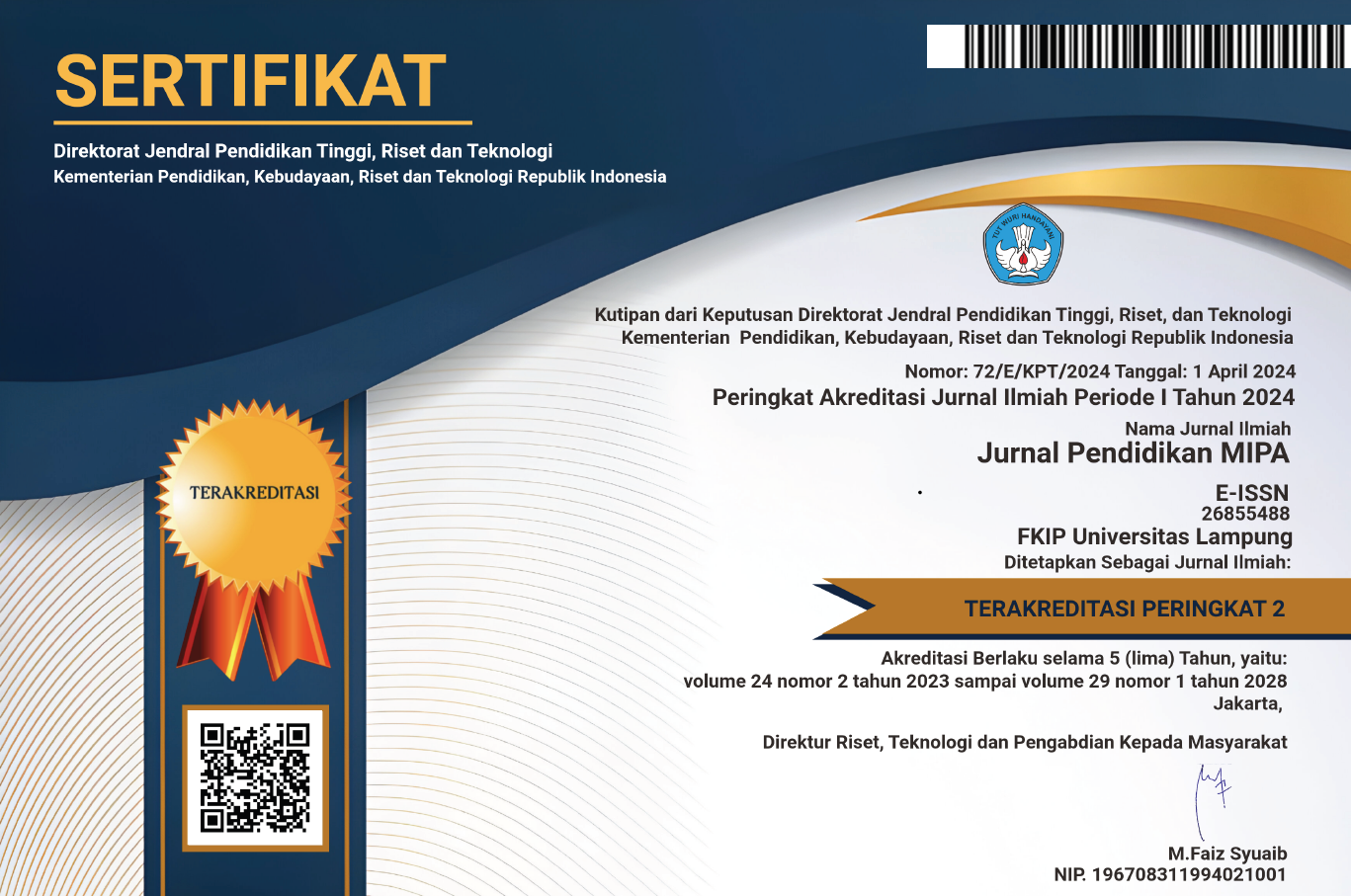Using Augmented Reality-Based e-Book for Improving Students’ Learning Motivation in Analytical Geometry Course
(1) Universitas Billfath, Indonesia
(2) Universitas Billfath, Indonesia
(3) Universitas Billfath, Indonesia
Copyright (c) 2022 Pukky Tetralian Bantining Ngastiti, Ahmad Khairul Umam, Aris Alfan
| Article Metrics→ |
| Indexing Database→ |
Abstract
In the development of science and technology in the world of education, students need to be introduced to a variety of varied learning media, one of which is the use of augmented reality-based e-books. The ability to learn analytic geometry requires systematic, logical and critical thinking that can be developed through learning. The purpose of this study is to test the increase in learning motivation using augmented reality based e-book media in analytic geometry course. The method in this study using ADDIE which consists of five stages which include analysis, design, development, implementation and evaluation. The result of the research is that the average result of the questionnaire given by students from various aspects of the assessment is 86%. Meanwhile, based on learning outcomes, there is a difference in learning outcomes between midterm exam score and the e-book score, which is 9.18 and based on the results of the analysis using SPSS on the t-test, it is found that tcount = 4.768 > ttable = 2.015. From these results, it can be concluded that augmented reality-based e-book media in analytic geometry courses can motivate students as a technology based learning medium for students of mathematics study program at Universitas Billfath.
Keywords: augmented reality, geometry analytic, e-book
References
Wen-H, C., & Rong-C, C. (2018). Using Augmented Reality to Enhance and Engage Students in Learning Mathematics. Advances in Social Sciences Research Journal, 5(12), 455–464.
Casmika, S. (2015). Satuan dan Dimensi, Vektor dan Koordinat. Kinematika: Catatan Fisika.
Mustika, R., Ceppi, G., Sanjaya, R., & Sofyan. (2015). Implementasi Augmented Reality Sebagai Media Pembelajaran Interaktif [Implementation of Augmented Reality as an Interactive Learning Media]. Citec Journal, 2(4), 277–291.
Andriyadi, A. (2011). Augmented Reality With ARToolkit. Nulis Buku: Bandar Lampung.
Permana, A. P., Nurhayanti, Oky, D., Martono., & Kurniawan, T. (2016). Perancangan dan Implementasi Augmented Reality Pemantauan Titik Reklame Kota Semarang Menggunakan QR-Code Berbasis Android [Design and Implementation of Augmented Reality Semarang Advertising Point Monitoring Using Android Based QR-Code]. Jurnal Teknologi dan Sistem Komputer, 4(2), 295–304.
Lyu, M. R. (2012). Digital Interactive Game Interface Table Apps for iPad. Final Project: The Chinese University of Hong Kong.
Mulia, S. (2017). Buku Ajar Geometri Analitik. Yogyakarta: Deepublish Publisher.
Hendarto, C. (2019). Geometri Analitik Bidang. Malang: UMM Press.
Hendrys, T. M., Ramon, F., & Silvia, B. (2015). Augmented Reality Game-Based Learning for Mathematics Skills Training in Inclusive Contexts. IE Comunicaciones, 21, 39–51.
Yu-ching, C. (2019). Effect of Mobile Augmented Reality on Learning Performance, Motivation, and Math Anxiety in a Math Course. Journal of Educational Computing Research, 57(7), 1695–1722.
Su, C., Enrui, L., Yang, Y., & Jyh‐Chong, L. (2019). Tablet‐based AR technology: Impacts on students’ conceptions and approaches to learning mathematics according to their self‐efficacy. British Journal of Educational Technology, 50(1), 248–263.
Francisco, D. C. V., & Ginés, M. M. (2021). Application in Augmented Reality for Learning Mathematical Functions: A Study for the Development of Spatial Intelligence in Secondary Education Students. MDPI Journals, 9(4), 369–388.
Sugiyono. (2015). Metode Penelitian Kuantitatif, Kualitatif, dan R&D. Bandung: Alfabeta.
Coimbra, M. T., Cardoso, T., & Mateus, A. (2015). Augmented Reality: An Enhancer for Higher Education Students in Math’s Learning?. Procedia Computer Science, 67, 332–339.
Gopalan, V., Zulkifli, A. N., Fadziana, N., Mohamed, F., & Alwi, A. (2016). Augmented Reality Books For Science Learning—A Brief Review. International Journal of Interactive Digital Media, 4(1), 2289–4098.
Kesim, M., & Ozarslan, Y. (2012). Augmented Reality in Education: Current Technologies and the Potential for Education. Procedia - Social and Behavioral Sciences, 47(222), 297–302.
Wu, H. K., Lee, S. W. Y., Chang, H. Y., & Liang, J. C. (2013). Current status, opportunities and challenges of augmented reality in education. Computers and Education, 62, 41–49.
Xavier, F., & Francis, M. (2017). Use of Multimedia (ICT) as an Educational Tool in High School Education—A Study. Amity Journal of Media & Communication Studies, 7(1), 31–37.
Billinghurst, M., Clark, A., & Lee, G. (2014). A survey of augmented reality. Found. Trends Human-Computer Interact, 8(2), 73–272.
Cascales, M. A., Martínez, S. M. J., Lopez, P. D., & Contero, M. (2017). Using an augmented reality enhanced tabletop system to promote learning of mathematics: A case study with students with special educational needs. Eurasia Journal Mathematics Science Technology Education, 13(2), 355–380.
Liu, Y. D., Holden, & Zheng, D. (2016). Analyzing students’ language learning experience in an Augmented Reality mobile game: An exploration of an emergent learning environment. Procedia - Social and Behavioral Sciences, 228, 369–374.
Dorouka, P., Papadakis, S., & Kalogiannakis, M. (2020). Tablets and apps for promoting robotics, mathematics, STEM education and literacy in early childhood education. International Journal Mobile Learning Organ, 14(2), 255–274.
Jung, S., Song, J. G., Hwang, D. J., Ahn, J. Y., & Kim, S. (2010). A study on software-based sensing technology for multiple object control in AR video. Sensors, 10(11), 9857–9871.
Saltan, F., & Arslan, O. (2017). The use of augmented reality in formal education: A scoping review. Eurasia Journal Mathematics Science Technology Education, 13(2), 503–520.
Cai, S., Wang, X., & Chiang, F. K. (2014). A case study of Augmented Reality simulation system application in a chemistry course. Computer Human Behaviour, 37, 31–40.
Martín, G. J., Mora, C. E., Añorbe, D. B., & González, M. A. (2017). Virtual technologies trends in education. Eurasia Journal Mathematics Science Technology Education, 13(2), 469–486.
Hamzah, M. L. (2021). Development of Augmented Reality Application for Learning Computer Network Device. International Journal of Interactive Mobile Technologies, 15(12), 469–486.
Refbacks
- There are currently no refbacks.

This work is licensed under a Creative Commons Attribution-ShareAlike 4.0 International License.

The copyright is reserved to The Jurnal Pendidikan MIPA that is licensed under a Creative Commons Attribution-ShareAlike 4.0 International License.


